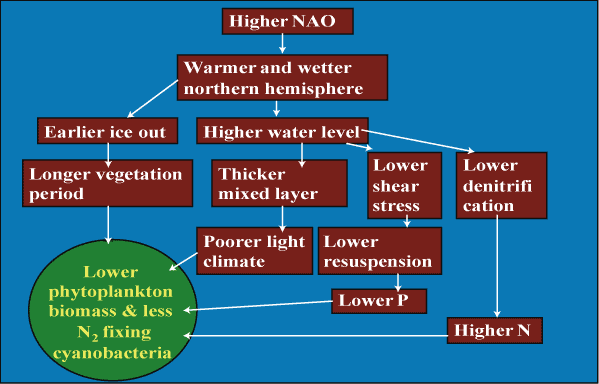


 |  |  | 21.6 Climate, water level and phytoplankton |
The North Atlantic Oscillation (NAO), which is defined through the variability of air pressure differences between the north (Iceland) and south (Azores), dictates climate variability over a large area of the Atlantic, North America, and Europe, especially during winter [240]. Variation in heat and moisture transport between the Atlantic and surrounding continents affect water balance components of lakes, such as precipitation, riverine inflow, and evaporation, resulting in changes in water level. In both Lakes Peipsi and Võrtsjärv, mild winters associated with high NAO index bring about higher water level (Figure 11).

For the ecosystem of Lake Võrtsjärv, warmer and wetter climate could bring about higher water levels. The deeper the mixed water column, the lower the average light intensity, resulting in reduced phytoplankton biomass [327]. Weaker resuspension in deeper water releases less phosphorus from the bottom sediments while lower denitrification rate keeps nitrogen concentration high [333]. Consequently, in a warmer world the N/P ratio in Lake Võrtsjärv would probably be higher and N2-fixing cyanobacteria will have less chance to develop (Figure 12).

A warmer and wetter climate will also affect watershed processes: reduced soil frost and increasing amount of precipitation will increase nutrient leaching from the soil and accelerate the eutrophication of water bodies. We have noticed that during the 1990s the spring peaks of riverine nutrient discharges shifted from the beginning of April to mid March. It is remarkable that despite abandoning of a substantial proportion of previously cultivated lands and decreased use of fertilisers, wintertime nutrient losses are almost as high as during former years because of increased water discharge and surface runoff in winter. Larger water discharges in winter, in combination with the still large nutrient pools in the soils, could explain the phenomenon that nutrient concentrations in lakes have decreased less than what might be expected from the reduced fertiliser applications.

 |  |  | 21.6 Climate, water level and phytoplankton |